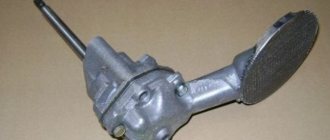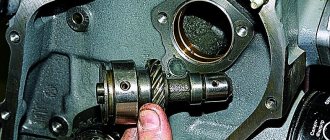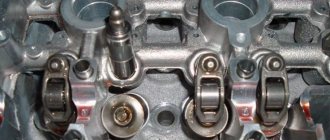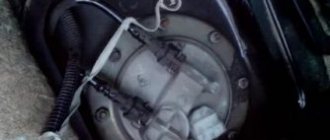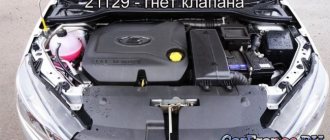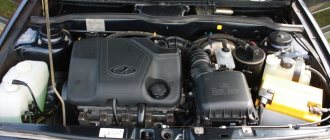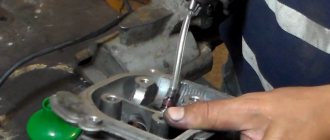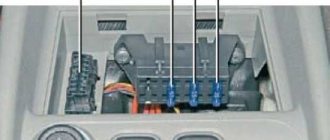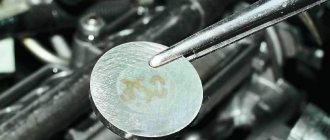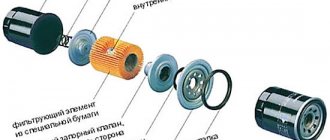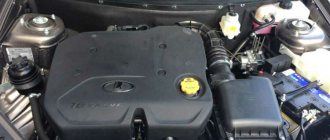Oil pumps for internal combustion engines of cars
Since different cars are equipped with different types of engines with different operating parameters, the design of oil pumps can also be different. All modifications of these devices are divided into adjustable and unregulated.
With adjustable models, it is possible to change the performance in order to achieve optimal system pressure under different conditions. In the case of unregulated devices, the parameters are adjusted using special pressure reducing valves.
In car engines, gear and rotary type oil pumps are most often installed. In this case, the movement of oil through the system and the creation of pressure is carried out thanks to rotor blades.
In gear type pumps, these same functions are performed due to the movement of gears. They can be made in two modifications - with an external type of gearing or with an internal one. A pump with an external gear has two gears located next to each other, while a pump with an internal gear has one inside the other. With the same performance, the overall dimensions of gear pumps differ according to the type of gearing.
Types of control valves
Devices are divided into two subgroups.
They differ in design and principle of operation.
- Direct acting gearboxes. The pressure in the line directly acts on the sensitive elements that control the regulation. It works using pressure energy in the main line.
- Indirect acting gearboxes. The pressure is sensed by a sensitive element and transmitted to a mechanism that compares the value with the set value and controls the executive bodies. This mechanism may use electronic components and require additional power.
Gearboxes are also divided according to the type of working environment:
- Air.
- Gas (carbon dioxide, acetylene, argon, oxygen, etc.).
- Oil in lubrication and hydraulic systems.
- Water in water supply and sewerage networks.
- Coolant in heating systems.
The working environment influences the choice of design, materials, and adjustment ranges.
Hydraulic gearboxes, in turn, come in piston and diaphragm types. Piston engines differ in that changes in inlet pressure do not affect the stability of output parameters. However, devices of this type are much more sensitive to dirt and foreign inclusions in the flow of the working fluid and require the installation of filters. In diaphragm reducers, differences at the inlet affect the constant pressure at the outlet; they are unpretentious and allow significant contamination of the liquid. They do not require a significant difference in inlet pressure to operate.
A spring-type pressure reducing valve is used to control the pressure when supplying gases, water, steam, and coolant solutions.
Purpose of the oil pump pressure reducing valve
But creating pressure is only the first step. This parameter needs to be monitored in the future.
Excessive pressure can lead to breakdown of key engine components, and its lack can lead to insufficient lubrication of elements and their overheating.
To avoid such problems, a pressure reducing valve was provided. At first glance, this is a simple unit, but without it, normal engine operation would be impossible.
The purpose of the oil pump pressure reducing valve is to control the oil pressure, weaken or increase it.
This is realized through two actions - opening the passage (to reduce pressure or prevent serious damage) or closing it (to ensure normal operation of the system).
Diagram and principle of operation of the lubrication system
The oil pump pressure reducing valve, as an element of any hydraulic system, is responsible for normalizing the pressure created by the oil pump. That's all its function. It would seem like such a small thing, but it affects the operation of all engine systems. Let's take a quick look at the lubrication system to understand the purpose of the valve in the operation of the system.
The lubrication system of any modern automobile engine is a combined type. This means that only some of the parts are lubricated by natural drainage or the drip method. The main part of the rubbing surfaces are lubricated under pressure. The lubricant must form an anti-friction film and reduce the coefficient of friction of parts. The cyclic principle of operation of the entire engine lubrication system involves constant circulation of oil from the crankcase through the filter. The oil pump ensures the movement of lubricant along the circuit. After this, the oil goes under pressure to the main and connecting rod journals of the crankshaft, and under pressure it passes through the oil line to the camshaft journals.
Video tutorial on how to remove a coked pressure relief valve
Through a channel inside the connecting rod, lubricant is cyclically supplied to the piston pin. All other parts are lubricated by flowing or splashing oil, which is converted into an oil film by the rotating engine parts. After this, the oil flows into the crankcase, where it is again sucked into the oil pump through the oil intake.
High-speed and sports engines have a dry sump lubrication system. Such a system does not depend on the amount of oil in the crankcase, because it is located in a separate oil tank, where it is immediately pumped after the lubrication cycle. The dry lubrication system does not depend on the position and level of the oil mass in the crankcase. This ensures stable operation of the engine in any mode and eliminates oil starvation of the engine at high speeds when the car overcomes uneven terrain.
Gear
The unit is arranged as follows. The drive and driven gears are installed in its housing. They ensure the movement of lubricant through a special channel into the oil system. Depending on the crankshaft speed, the pump performance changes. If the oil pressure is higher than the permissible standard, then part of the lubricating fluid is directed to the suction part or directly to the crankcase using a pressure reducing valve. Gear pumps do not have automatic adjustment capabilities.
Oil pump pressure reducing valve design
The operating principle of the system is simple. The main reacting body in this unit is the thrust bolt. It is he who puts pressure on the spring and presses the valve to the hole.
As soon as the pressure in the system increases and exceeds the permissible level, the oil overcomes the elasticity of the spring, squeezes out the valve and passes into a special compartment.
After the pressure normalizes, the spring returns the valve to its original state, and the engine operates normally.
The oil pump pressure reducing valve has a simple design:
- A small casing in which a special system of channels is provided (it is through them that the oil moves);
- a special valve that looks like a small piston or ball. Its task is to block the passage in a timely manner and prevent an increase in pressure in the engine;
- spring;
- a thrust bolt (sometimes a screw).
The pressure reducing valve itself is produced in two versions - it can be located in the pump housing (built into it) or have the form of a separate mechanism.
As you can see, the system is well thought out. But even such high-quality devices sometimes fail. Let's look at the main valve malfunctions and how to eliminate them.
In appearance, the removable oil pump pressure reducing valve resembles a bolt consisting of several parts: a housing with a channel for oil drainage (or several), the valve itself, a spring and an adjusting (thrust) screw. When assembling the engine, the adjusting screw adjusts the spring compression and the valve actuation force.
The oil pressure in the engine depends primarily on the engine speed. When we press the gas pedal, the speed of the oil pump gears and the oil pressure in the engine also increase. As soon as the oil pressure exceeds a certain level, it presses the valve spring and flows through the channel into the engine crankcase until the oil pressure becomes weaker than the spring pressure and the valve closes the channel again.
As you can see, the device is very primitive, but at the same time quite effective.
In general, having delved into the principle of operation of this mechanism, you can find that it is quite simple. So, the main element that reacts to what is happening in the oil line is a special thrust bolt. This bolt, under the influence of the external environment, presses on the spring, which already presses or releases the valve in relation to the cross-section of the passage.
If the oil pressure in the system begins to increase and, at the same time, exceeds the permissible maximum pressure level, then the oil will overcome the resistance of the regulator (simply springs) and squeeze it into the seat. In this way, the pressure indicator will stabilize, the spring will return to its normal position, and the car engine will be able to continue to function normally. Technically, the valve structure is as follows:
- A relatively small body, inside of which a special system of channels is machined. Oil moves through them.
- The spring, rod and body of the regulator lower and increase oil pressure.
It should definitely be said about how simple the design of this valve is - all functions are performed by elementary actions. Due to the elementary nature of the components, a high level of reliability is ensured.
It should also be noted that the pressure regulator can technically be designed in two versions. The first involves placing the housing inside the pump, without separating the two devices. The second option is that the valve has its own separate body and is located somewhere along the oil line. Considering the conditions under which the valve has to operate, it is not surprising that breakdowns also occur periodically. This point should also be given attention.
Oil pressure valve device
The valve consists of a special casing. Along its entire length there is a system of channels through which the lubricant circulates. At the end of the circulation channel there is a bolt or ball. This element opens or closes the channel to allow or limit the flow of oil.
The main difference between this pressure regulation system is that it is extremely simple. Its design is more reliable and maintainable than electric or any other types of valves.
The valve can be either part of the entire pump or its separate element. The second option provides a modular system, the faulty unit of which can be easily replaced.
Rotary
The design of this type of unit is a little more complicated. The device consists of two rotors - driven and driven. Both are enclosed in a housing.
If the pump is unregulated, then the oil that is sucked into the device passes through the rotor blades. If the pressure level in the system is higher than the nominal or calculated pressure, then the pressure reducing valve is activated to relieve excess pressure.
Adjustable devices have a special movable stator equipped with a spring. It regulates and ensures constant oil pressure regardless of the engine speed. The stator is designed to control constant pressure by varying the volume of the cavity between the rotors. To do this, the stator is rotated in the required direction.
Where is the oil pump located on the VAZ 2108/2109, what is it responsible for
The oil pump in the engine design of every car is an important and integral mechanism, which is designed to create a certain pressure in the engine lubrication system. The design of the unit comes in various forms and can be driven by a camshaft or crankshaft.
On such common models as the VAZ 2108/2109, the device for circulating oil in the system is located behind the crankshaft pulley. Looking under the hood, you won’t be able to examine it so easily: this can only be done after removing the crankshaft pulley from the engine.
The pump is fastened to the cylinder block using six bolted connections, which ensures reliable fixation of the entire structure.
Common valve failures
The oil pressure in the system drops if the fluid level in the engine crankcase drops. It is also possible that the pump has nothing to do with it, but the device that monitors the pressure has failed. One of the popular reasons is low-quality oil or a product unsuitable for a particular type of engine. Often the oil pump fails due to natural wear and tear. It happens that the pressure relief valve fails.
1. Inability to maintain normal blood pressure. As a rule, this is caused by mechanical failures of the unit. The weakest element of the system is the spring.
During operation, it can stretch and open the valve even with a slight increase in pressure. As a result, oil does not reach many engine components, they wear out and fail.
The reasons for a spring malfunction are its wear due to long-term operation, installation of the wrong spring during a major overhaul (defective or excessively soft), and installation errors.
2. Problems with opening the valve when peak pressure is reached. During operation, the valve lumen may become clogged. As a result, the RKMN jams and does not open even at high pressure.
The result is the destruction of many important engine components and the need for major repairs. The main cause of the malfunction is untimely oil change.
It's easy to explain. Dirt particles are deposited on the surface and constantly increase the size of the growth. Poor flushing quality leads to the accumulation of various debris and chips in the channels.
The sealing washer must be replaced with a new one after each disassembly of the mechanism.
So, there are a number of the most common oil pressure valve failures. They also manifest themselves in different ways, so let’s devote a little time to this moment. The first common problem is the inability of the regulator to maintain the parameters required by the engine. This happens due to failure of the mechanical parts of the device.
https://www.youtube.com/watch?v=DT2aupjaztg
As a rule, this happens due to the breakdown of a weak element of the device - the pressing spring. If the spring has not been replaced over many thousands of kilometers traveled, then over time it becomes stretched and no longer holds the valve. As a result, the opening of the passage in the housing may occur when it is not necessary. This will lead to a lack of lubrication in places where it is urgently needed.
Scouring on the surface of the plunger is one of the possible causes of malfunction.
The second common problem is improper installation of the pressure regulator or lack of maintenance. Here the problem is expressed by the valve not opening when the pressure exceeds the permissible level. This happens due to clogging of the flow area or wedging of its individual elements. The result is a lack of normal lubrication, which will lead to failure of individual engine components and assemblies.
As a rule, the valve becomes clogged due to the fact that the engine oil is not changed in a timely manner. Solving such a problem is quite difficult; more often it comes to completely replacing the valve, since it is quite difficult to find individual small components. It is not difficult to prevent the problem - wash the engine before each oil change and replace the latter according to the manufacturer's regulations.
Equipment classification
The oil pump and pressure maintenance valve have a certain classification according to their design. The pumps are:
- Adjustable;
- Unregulated.
In the adjustable version, constant pressure is maintained by changing the position of one of the pump parts. But the device of the unregulated version could not do without the use of a pressure reducing valve. Each of the options discussed above is divided according to the structure of the mechanism into gear and rotary.
In turn, oil pressure regulators are of hydraulic and pneumatic types, regardless of the type, both of them are designed to maintain pressure at a given level. Based on the power source, valves are of the following types:
- Reduction, controlled by a pneumatic drive;
- Electrically driven;
- Autonomous, not requiring a power source.
Now it’s time to consider the purpose and operating principle of the pressure reducing valve.
Valve Tasks
As already mentioned, the oil valve is necessary to maintain the pressure at a certain level. After the engine has started, the task of the pressure reducing valve is to stabilize the pressure and maintain the level throughout the entire period of engine operation.
If the pressure drops below the nominal level, this will mean that some engine parts will lose normal lubrication, and a breakdown will soon occur.
During operation, the regulator controls the speed of oil movement: increases or decreases it, depending on what is required at that particular moment. This is accomplished by fully opening the valve and lowering it, whereby the pressure decreases, or by partially opening it, where it begins to increase. Each of these actions is performed at the moment when it is needed; thanks to its device, the regulator determines this independently.
Symptoms of a problem
Although oil pumps are simple in design, they still do not last forever. From time to time they may fail. Before you learn how to check the oil pump, you need to understand the typical faults and their causes.
So, frequent breakdowns include damaged gaskets and clogged oil filters. Another malfunction is not directly related to the pump - it is incorrectly fastening the oil filter. Failure of the device also occurs due to increased wear of the main elements. Another typical malfunction is a broken pressure relief valve.
To understand how to check an oil pump, you need to be able to determine the causes of failure based on their symptoms.
One of the first signs that the pump is damaged is the oil pressure light on the dashboard. If it lights up, you urgently need to make sure that the pressure in the system is normal. If it is below normal, then the pump should be checked. Also pay attention to the amount of lubricant and its consumption.
In the oil pump pressure reducing valve, as in other similar valve devices, two types of malfunctions can occur. The first is the wear of the spring, as a result of which the valve will open even at low pressure and threaten the engine with insufficient oil pressure. The second is, on the contrary, failure to open the valve even with excess pressure due to jamming of the piston (ball) or clogging of the valve hole.
The first type of malfunction can be avoided by monitoring the light bulb or oil level sensor. If it periodically reports insufficient oil pressure (even for a short time), it is worth checking the serviceability of the spring in the valve. After replacing the spring, its compression should be adjusted while simultaneously monitoring the oil pressure in the engine using a special pressure gauge. It is better to entrust this operation to specialists.
As for valve jamming and clogging, this can be avoided by following the established technical regulations for changing engine oil, and periodically conducting an external inspection of the engine for oil leaks. It is recommended not to overheat the engine and change the oil pump along with the valve after a major engine overhaul.
How to determine if an oil pump is faulty
There are two types of pump testing - without dismantling it and with dismantling it. Without removing the pump, you can verify its malfunction only when it is already in a “dying” state, so it is better to remove it to perform detailed diagnostics.
How to check the oil pump without removing it
Before directly testing the pump, it makes sense to check the oil pressure in the system using a pressure gauge. This way you can make sure that the oil pressure light is working correctly and did not light up in vain. To do this, a pressure gauge is screwed in instead of the emergency lamp pressure sensor.
Please note that the pressure value often drops precisely “when it’s hot,” that is, when the engine is warm. Therefore, the test must be carried out on a warm engine and at idle speed. The minimum and maximum pressure values will differ for different machines. For example, for a VAZ “classic” (VAZ 2101-2107) the minimum emergency pressure value is 0.35...0.45 kgf/cm². It is under such conditions that the emergency lamp on the instrument panel is activated. The normal pressure value is 3.5…4.5 kgf/cm² at a rotation speed of 5600 rpm.
On the same “classic” you can check the oil pump without removing it from its seat. To do this, you need to dismantle the distributor and remove the pump drive gear. Next, evaluate her condition. If there are numerous scuffs on its surface on the blades or on the gear axis, then the pump must be dismantled. It is also worth paying attention to the gear splines. If they are knocked down, it means the pump is jammed. This is usually due to debris and/or sludge in the oil.
Repair recommendations
If there are signs of a valve malfunction (for example, a pressure lamp on the dashboard lights up), you must promptly repair the problem.
To do this, remove and disassemble the oil pump. After opening you will see the pressure reducing valve and will be able to assess its condition.
If it's stuck, take it out, wash it in gasoline and don't forget to lubricate it. Similar flushing actions are done with the fuel pump.
Pay special attention to cleaning the valve channels and diagnosing the main elements. If the spring is faulty, it needs to be replaced.
Please note that the installation of a new oil pump (reducing valve) is required after each overhaul of the power unit.
In this case, you can avoid many problems with pressure surges or, conversely, lack of pressure. Once the repair is complete, be sure to check the system pressure to ensure the readings are accurate.
In the future, change the oil promptly, flush the engine and install a new filter at each replacement.
There are no small things in a car. Even the most insignificant at first glance node can play an important role in the overall “orchestra”.
This theory was once again confirmed by the pressure reducing valve, which requires special attention, timely diagnosis and repair. Good luck on the roads and of course no breakdowns.
Let's look at how to test a removed oil pump. The check consists of visual inspection, measurements and comparison of the measurement result with the nominal dimensions.
Unscrew the oil receiver cap together with the pressure reducing valve. It is worth making an effort so that the spring thrust washer does not get lost. Next, note that some bolts will be smaller than others. This bolt should then snap back into place.
Use a caliper to measure the spring. At rest, it should be at least 38 millimeters in length. Then remove the cover, which will have marks from the wear of the gears. If the scoring is deep, then the oil pump has a lot of wear. The cover can be repaired - its plane should be leveled.
Next, remove the drive gear and visually check the condition of its teeth. If there are abrasions and burrs on the teeth, this indicates a lot of wear. The driven gear should also be checked. The main thing about it is the hole in which the fixation axis is located.
Then check the walls of the device housing and the axis of the driven gear. Potholes, grooves, and various defects indicate that debris has entered the working area inside the pump.
Repair and malfunction of pressure reducing valve
With such a simple device, it is quite obvious that the valve can have only two malfunctions - it either does not open at elevated pressure, or is not tightly locked, which leads to a decrease in pressure in the lubrication system. Both options are dangerous. In the first case, valve malfunctions are fraught with crushed oil seals, gaskets and seals, and torn hoses. All this leads to oil leakage and, for obvious reasons, to failure of the crank mechanism at a minimum.
To avoid this trouble, you should look at the oil pressure scale from time to time. High pressure is good, but when it gets too good, you need to disassemble the pressure relief valve and make sure it is working. Replacing the spring or cleaning the valve seat will help eliminate the problem. You can check the pressure with a pressure gauge, which is connected to the lubrication system, most often instead of a pressure sensor. This is the most accurate method for diagnosing the lubrication system.
A clogged valve can cause a lack of optimal pressure in the oil pump.
The second extreme is when the pressure relief valve does not maintain the minimum pressure. This situation also does not lead to anything good. As a rule, this is due to a clogged valve. Debris or slag gets into the valve seating plane and prevents it from blocking the drain channel. The valve is jammed, as a result the pressure in the system drops, and how this ends is known. To signal critical pressure in any car there is a warning lamp on the instrument panel, and in modern engines the ECU simply turns off the engine if the pressure drops to a critical point.
Monitoring instrument readings is important. LED lighting of instrument panels is great, but it wouldn’t hurt to buy and install an additional pressure gauge for the lubrication system, preferably a mechanical one, as part of tuning the device. It is more expensive and more complicated, but it more objectively reflects the condition of the lubrication system in the engine.
When starting the replaced engine for the first time, the blinking oil pressure light did not go out. On T3, it receives a signal from two sensors: on the cylinder head (if the oil pressure is less than 0.3 bar, the lamp flashes) and on the oil filter housing (if at rpm above 2000 the pressure is below 1.8, the lamp lights up and the buzzer sounds). Once again the first thought: “Well, everyone has arrived!” Unscrewed the sensor on the filter housing. I turned the starter and no oil came out. I calmed down a little. The engine is not to blame - the pump does not pump oil.
The minivan's pump is original due to the tilt of the engine, removed from the previous one.
Already in the dark, I dropped the pan, unscrewed and disassembled the pump. I didn't find anything criminal in appearance. I didn't measure the gaps. I did not remove the pressure reducing valve (according to the engineers’ plans, it was made non-removable). Even then I thought that it would be necessary, because as a result of damage to parts of the previous engine, chips could get into the housing (there were plenty of them in the pan). At night on Drive I read about a trick: after replacing the pump, you need to pump oil into it with a syringe through the hole supplying the filter. In the morning I put everything back, just in case I blew a compressor into the channels (I was worried that deposits might accumulate there), and squirted some oil through the oil cooler housing (I don’t know what came of it).
Started the engine. The lamp went out. Hooray! A couple of days later the same story again. I took off the filter, blew, squirted, started it - the light went out. I realized that there was some kind of problem, but then I forgot about other concerns. Some time later, after another trip on the highway, during which, by the way, I learned that the diesel engine heats up precisely in this mode (while the gasoline engine is cooled), I unloaded the passengers and things, turning off the engine. Then he started it up, moved the minibus and began to connect the radiator fan directly, just in case (the weather was already hot). When I start it up to drive again, the pressure light blinks. I turn the sensor out and no oil comes out. I repeat the previous operations - empty. I notice that the oil cooler is unscrewed. I tighten the nut. I turn the starter - there is no oil.
Checking with a pressure gauge
In fact, there are not many ways to check the oil pump. The performance check is carried out using a pressure gauge - this way you can verify the level of oil pressure. Then you need to dismantle the device and perform troubleshooting followed by repair or replacement.
Every car owner should know how to check the pressure of the oil pump on a car - this will allow it to avoid dangerous consequences for the engine in case of malfunctions.
A pressure gauge is installed instead of an oil pressure sensor. This is the only way that allows you to reliably verify the serviceability or malfunction of oil pumps. In this case, the pump itself does not need to be removed from the engine. You can purchase ready-made kits for measuring pressure in the lubrication system or make the device yourself.
Instructions for verification
So:
- First, check the serviceability of the electrical circuit going from the sensor to the instrument panel
. Throw the wire going from the sensor to the engine to ground, the light will go out if the circuit is working properly. - The second reason could be the oil filter. Such a breakdown is determined by unscrewing the oil pressure sensor. It should be moistened with oil; a dry sensor means that the filter is clogged or its valve is stuck.
- When it does not work, open the pan and check the oil receiver itself and the condition of its rubber sealing ring.
- After these checks, one reason remains - a breakdown of the unit itself.
For your information:
- The engine of the VAZ 2110 model is equipped with a combined lubrication system. On machines of this model there is a gear oil pump, which is located at the front end of the cylinder block.
- Special gears with trochoidal internal gearing reduce mechanical losses during rotation.
- The oil pump itself is equipped with a fully in-line, non-separable filter. With bypass and anti-drainage valves. This device ensures good oil circulation and lubrication through all components of the internal combustion engine (ICE).
- It works by rotating the crankshaft. The connection method to the crankshaft is direct, which is typical for all VAZ cars with front-wheel drive.
- On all-wheel drive and classic models, the system is supplemented with special transmission parts: a timing chain, an intermediate shaft, and a set of gears that transmit torque from the crankshaft.
- The service life of this pump is from 120 thousand km, it works properly when the engine has already undergone a major overhaul. However, during operation, breakdowns are not excluded.
If replacement is still required, it is better for you to choose the VAZ 2110 oil pump from among reliable manufacturers.
Operating procedure
So:
- Disconnect the negative cable from the battery terminal.
- Drain the oil from the engine (through the drain plug in the oil pan).
- We take out the camshaft drive belt.
- Now remove the oil sump.
- On engines with a fuel injection system, disconnect the block with wiring from the sensor that counts crankshaft revolutions.
- Using two screwdrivers, remove the pulley from the crankshaft.
- If the key does not fit tightly in the crankshaft groove, take it out so that it does not get lost.
- We unscrew the bolts securing the oil receiver (there are three bolts, there are flat washers under the bolts) and remove the oil receiver.
- We clean the oil receiver mesh from dirt and wash it with white spirit. When the mesh cannot be washed or is damaged, we replace the oil receiver.
- We replace the lost elasticity or torn sealing ring of the oil receiver.
- We unscrew the bolts securing the oil pump to the cylinder block (there are six of them) and remove the pump along with the gasket. Be careful - there are flat washers under the bolts.
- We turn the pump drive gear to ensure correct installation on the crankshaft: the protrusions on the gear should coincide with the flats on the crankshaft.
- Before installing the pump in place, lubricate the lip of the oil seal.
- When putting the pump in place, carefully tuck the working edge of its oil seal onto the crankshaft journal using a wooden stick.
- Only after this do we tighten the bolts securing the pump.
- Then install all the parts back in reverse order.
- Adjust the tension of the camshaft drive belt.
For VAZ 2110, replacement of the oil pump is completed. Remains in the engine. We also recommend watching a video on replacing the oil pump.
Expert advice
In order to check the operation of the oil pump, you will need a liquid pressure gauge. These devices are available in auto parts stores. You can also use any industrial pressure gauge for these purposes, but you should pay attention to the measuring scale - it must be adequate. Then you should stock up on an adapter, which should be screwed into the sensor hole.
To make an adapter, you need to know the parameters of the mounting hole and thread parameters. Then a sketch is drawn up based on this data. Another option is to show the machine operator an old or broken one, or maybe even a working one, and he will use it to turn the required part.
Experienced drivers know another way to check the serviceability of the oil pump. Here you can do without a turner. They take a faulty or old oil pressure sensor, remove everything inside and make an adapter based on it. For VAZ you can find ready-made tee fittings on sale.
Selecting a new fuel injection pump bypass valve
Finding the right valve won't be that difficult. Despite the simplicity of this product, it is not always cheap. The price will largely depend on the manufacturer. It is not recommended to continue operating a vehicle with a faulty injection pump bypass valve. Here's how you can find it in online and offline stores:
- According to the spare part code, if you know it;
- According to the vehicle and diesel unit;
- By VIN code.
Keep in mind that when searching by car parameters, you must accurately indicate the parameters of the units . If you make even a small mistake, there is a risk of choosing a spare part that simply cannot ensure normal operation of the fuel pump. Also keep in mind that some products allow adjustment, but this must be done in accordance with the instructions for servicing and repairing your vehicle. And lastly: it is important to pay attention to the manufacturer. Ideally, you should buy an original valve, since the quality of its performance will be guaranteed to be high. Spare parts from the following manufacturers will cost slightly less than the originals:
- Bosch (Germany);
- Denso (Japan);
- Meat&Doria (Italy).
In fact, these are all the same originals, but under the names of the manufacturers. If they seem too expensive to you, then you can take a risk and take lower quality, but much cheaper analogues from Chinese and Turkish manufacturers, as well as European packers. Here it is worth highlighting ATY (Turkey), SAT (China) and TQParts (Ukraine). Remember that the quality of inexpensive analogues can vary from extremely low to satisfactory. If you are interested in a reliable and durable solution for repairs, then you should choose products from suppliers to the conveyors of automobile concerns.
On a hot engine
As the oil temperature drops, its viscosity rises. This is good for efficient pump operation. To obtain adequate measurement results, it is best to measure pressure on a warm engine. Since the oil heats up much more slowly than the coolant, the engine is allowed to run a little longer after reaching operating temperatures.
In the lubrication system of a working engine with a working pump, the pressure should be in the range of 3.5-4.5 kgf per square centimeter at a crankshaft speed of 5600. If the measurement values differ from the nominal value, then the engine will experience a lack of lubrication in some modes.
Useful tips
Finally, here are some useful tips that may help you avoid problems with the oil pump pressure reducing valve or make it possible to identify its malfunction in time:
- Fill the engine only with high-quality motor oil of the appropriate type and viscosity grade. Lubrication requirements can be found in the vehicle manufacturer's recommendations.
- Never mix different brands of oils, even if they are of the same class.
- Change the oil and oil filter in a timely manner. The regulations for this procedure are also indicated in the car owner's manual.
- Do not allow dirt, moisture, or process fluids to enter the lubrication system.
- Monitor oil pressure. When the corresponding warning light on the device turns on, do not hesitate to go for diagnostics.
- Pay attention to the operating temperature of the engine. Overheating can cause coolant to enter the lubrication system.
- If you decide to replace or adjust the oil pump pressure relief valve without the necessary skills and tools, it is better to use the services of specialists.
